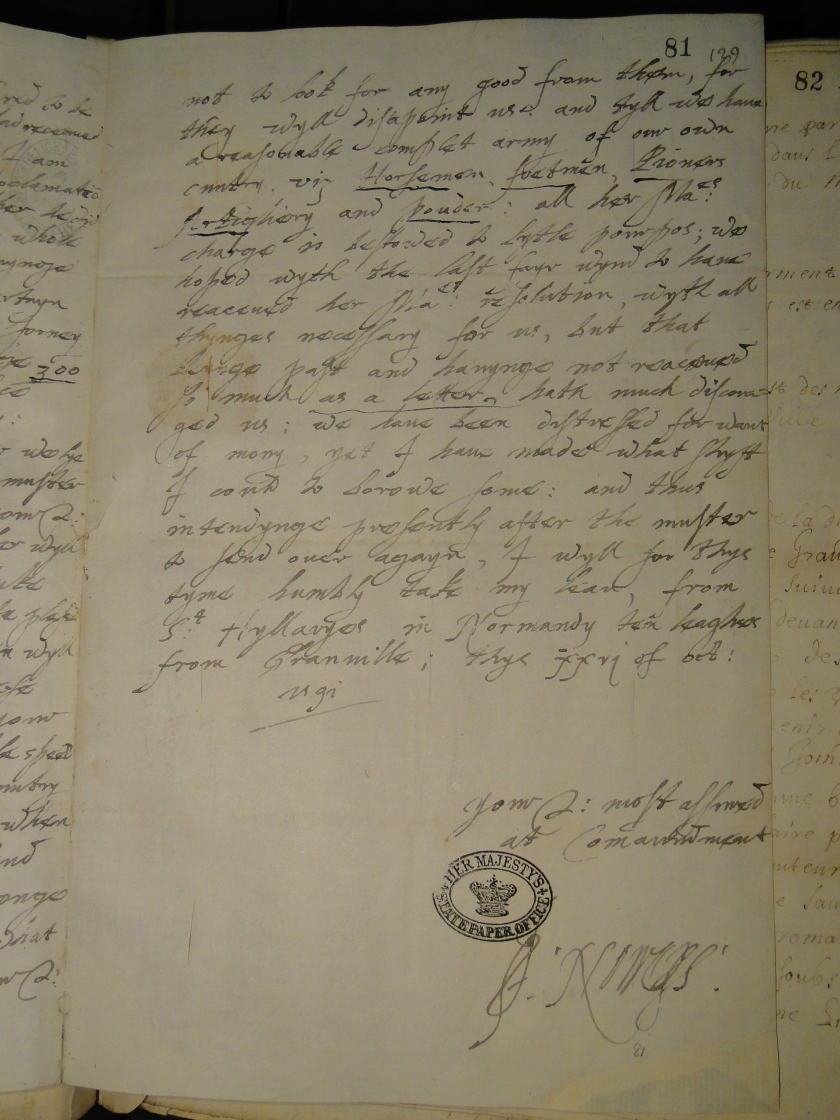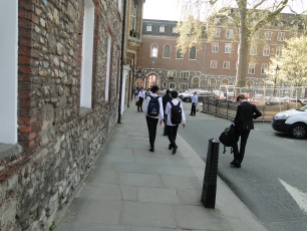We could have used another week on this trip, but I don’t know where I’d have gotten the energy for it! We were down to our last full day in London (Friday) and then it was back to the colonies the next. As the sun came up, it was hard to see how any day could hope to compete with the day before – but this day was a fighter! It started with a “before hours” escorted visit to inspect and photograph the massive Norris Monument (normally not approachable by the public) in Westminster Abbey. This was followed by a tour of Richard Lane’s boyhood school, the Westminster School, which is still in business. Then, we were off to the National Archives in Kew to spend the afternoon going through a long list of documents I’d reserved for viewing. Among these were three original letters to and from Richard Lane in exile during the last few months of his life…
Westminster Abbey and the Norris Monument
The first church on the site of Westminster Abbey was built in the seventh century (about 200 years after the withdrawal of the Romans), and it was expanded into the Abbey we recognize in the mid-1200s. Since that time, it has become the most sought after hangout among the A-list of the dearly departed of England.
As you may recall from my two earlier articles on Maximillian Norreys (first article and second article), his grandfather Henry Norris was executed with Queen Anne Boleyn, leaving their children, Henry Norris (the younger) and the toddler Princess Elizabeth as childhood companions who became lifelong friends. Ultimately, Henry Norris would have 7 children – six sons and one daughter. Every male member of the household (including Henry) was knighted under Queen Elizabeth except the youngest son (Maximillian) who didn’t live long enough to justify the honor. 24 year old Maximillian died fighting in France in 1591 under his older brother John, who was a famous General in Queen Elizabeth’s armies. Maximillian Norrey’s latin-inscribed tomb in the Parish Church of St. Helier, Jersey would become a key point of reference used by Jean Chevalier in his accounts of several burials in that church.
I mention all this because our first appointment on Friday was a “before hours” arranged visit to inspect the Norris family monument in Westminster Abbey. This monument is a bit of an enigma – it is massive, standing 2-1/2 stories tall. It includes spectacular life-sized individual depictions of every member of that family except the daughter, Catherine. But the monument is uninscribed, and was placed at the end of a narrow enclave that only avoids being cut off by the monument by the fact that the Norris monument is quite literally fused into another monument in the eastern wall, providing a scant few feet of access around its other end. That such a grand monument would be commissioned and then relegated (not quite completed) to such a location in the abbey seems fascinating evidence of the changing politics due to the end of the Tudor reign (during which I have established it was commissioned) and the first of the Stuart reign (during which it was delivered and installed).
Interestingly, friends of Mary’s we visited the week before in Hazelmere told us there is an ongoing annual ceremony where the Norris family provides a single rose to an official somewhere in London. I have some legwork to do to understand this ceremony, and also to work through the significant additional information Christine (at Westminster Abbey) has provided regarding this monument. There will definitely be another article once I get my hands around all of this! In the meantime, how interesting to look into the face of young Maximillian…

Westminster School
Westminster School was originally built in the 1500s and was the boarding school Richard Lane attended as a boy, before he left for Cambridge at age 18. The school functions today in much the same role it has in 5 centuries since it was opened. We received an excellent and gracious tour, which included materials showing what the school looked like, and how it operated at the time Richard Lane was a young student. Of course, there will be an article about this school in the next few months, which will help fill in a good bit of my understanding of his younger years. The school has been the launching pad of many of England’s most notable figures!
The National Archives
We spent the afternoon in Kew (on the western side of London), at the National Archives. I had reserved a number of materials here, most of which will require some investigation to fully understand, as many are legal documents involving various members of Richard Lane’s world.
But one of the absolute treasures of the trip was the three letters by/to Richard Lane while he was in exile. Because the existing digital copies were of rather poor quality, Dr. Johnson (a specialist there in documents of this period) was gracious enough to have the originals retrieved from “Deepstore”. I had hoped to meet Dr. Johnson while we were there, but sadly, it didn’t work out. But I am deeply grateful for his assistance with these documents, as these three letters were gems to me.
The bonus of the day was that one of the letters included a personal seal – apparently made by a signet ring. I was shocked when I saw it – and it left no doubt about the author of the letter. The seal was a perfectly formed, intact seal of Richard Lane’s first heraldic arms in brilliant red wax (matching the arms of his Reader’s plaque in Middle Temple Hall). What a stunning find!

Finally, we managed, through a rather odd and frustrating ordeal while trying to view the will of Richard Lane the younger (which was legible, but seemed to be made by old photocopy technology), we found ourselves looking at something we still don’t understand. Apparently, there are two wills of Richard Lane (the Groom) in the National Archives. They seem to be worded similarly, so I don’t yet understand their relationship. Was one a draft will, or an earlier version? The one we were able to view was not nearly as pretty a document as the other, but included a personal seal in black wax. Unfortunately, this was very difficult to obtain a reasonable image of. Another intriguing thread to pursue!
Although we had planned to make our way to the National Portrait Gallery in the evening, we decided to leave that for another trip. It was time to meet Anna and Stephen for a well deserved pint and relax! Anna (who was the original Societe Jersiaise contact who made the connection between the Richard Lane I was searching for and the account of “Milord Keeper” in Chevalier’s diary) has recently moved to London, so it was wonderful to be able to see her again. And Stephen (who I met at the London Museum last year) brought his heirloom copy of Lord Clarendon’s “History of the Rebellion”. It is possible that it was Lord Clarendon’s house in the upper ward of the Elizabeth Castle to which Richard Lane was brought by the Duke of York (later King James II) and Sir George Cartaret, and where he may have died. Spending some time with them and a good beer was a wonderful way to end the day!
The next day, it was off to sunny Heathrow and a flight home. Three movies and many rounds of “Sequence” with Mary later, we emerged to a playful irony of the travel Gods: it was raining in Denver!
– Greg
































Fascinating as always. Is Macimillian the very Young looking Norreys with the curly hair and hand to his chest?
LikeLike
No, he’s the bearded one. The other is Sir Edward Norreys, the third born son. He was the last survivor of the family, and died the same year as Queen Elizabeth: 1603. His open arms signify that he was alive when the monument was designed. At that point, he was the only one left.
LikeLike